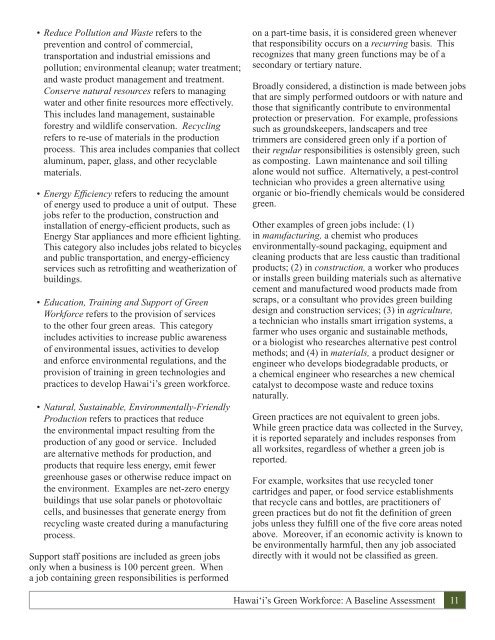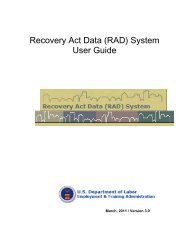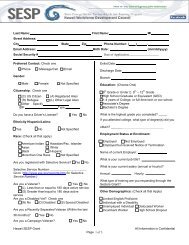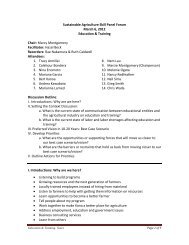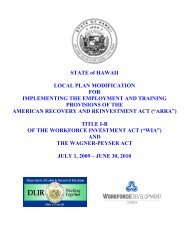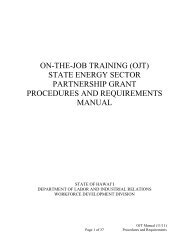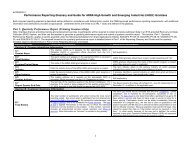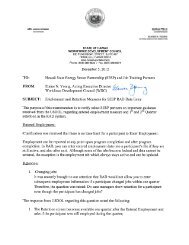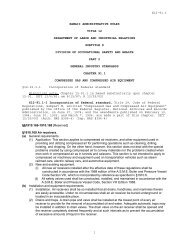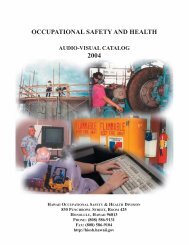Hawai i's Green Workforce A Baseline Assessment December 2010
Hawai i's Green Workforce A Baseline Assessment December 2010
Hawai i's Green Workforce A Baseline Assessment December 2010
Create successful ePaper yourself
Turn your PDF publications into a flip-book with our unique Google optimized e-Paper software.
• Reduce Pollution and Waste refers to the<br />
prevention and control of commercial,<br />
transportation and industrial emissions and<br />
pollution; environmental cleanup; water treatment;<br />
and waste product management and treatment.<br />
Conserve natural resources refers to managing<br />
water and other finite resources more effectively.<br />
This includes land management, sustainable<br />
forestry and wildlife conservation. Recycling<br />
refers to re-use of materials in the production<br />
process. This area includes companies that collect<br />
aluminum, paper, glass, and other recyclable<br />
materials.<br />
• Energy Efficiency refers to reducing the amount<br />
of energy used to produce a unit of output. These<br />
jobs refer to the production, construction and<br />
installation of energy-efficient products, such as<br />
Energy Star appliances and more efficient lighting.<br />
This category also includes jobs related to bicycles<br />
and public transportation, and energy-efficiency<br />
services such as retrofitting and weatherization of<br />
buildings.<br />
• Education, Training and Support of <strong>Green</strong><br />
<strong>Workforce</strong> refers to the provision of services<br />
to the other four green areas. This category<br />
includes activities to increase public awareness<br />
of environmental issues, activities to develop<br />
and enforce environmental regulations, and the<br />
provision of training in green technologies and<br />
practices to develop <strong>Hawai</strong>‘i’s green workforce.<br />
• Natural, Sustainable, Environmentally-Friendly<br />
Production refers to practices that reduce<br />
the environmental impact resulting from the<br />
production of any good or service. Included<br />
are alternative methods for production, and<br />
products that require less energy, emit fewer<br />
greenhouse gases or otherwise reduce impact on<br />
the environment. Examples are net-zero energy<br />
buildings that use solar panels or photovoltaic<br />
cells, and businesses that generate energy from<br />
recycling waste created during a manufacturing<br />
process.<br />
Support staff positions are included as green jobs<br />
only when a business is 100 percent green. When<br />
a job containing green responsibilities is performed<br />
on a part-time basis, it is considered green whenever<br />
that responsibility occurs on a recurring basis. This<br />
recognizes that many green functions may be of a<br />
secondary or tertiary nature.<br />
Broadly considered, a distinction is made between jobs<br />
that are simply performed outdoors or with nature and<br />
those that significantly contribute to environmental<br />
protection or preservation. For example, professions<br />
such as groundskeepers, landscapers and tree<br />
trimmers are considered green only if a portion of<br />
their regular responsibilities is ostensibly green, such<br />
as composting. Lawn maintenance and soil tilling<br />
alone would not suffice. Alternatively, a pest-control<br />
technician who provides a green alternative using<br />
organic or bio-friendly chemicals would be considered<br />
green.<br />
Other examples of green jobs include: (1)<br />
in manufacturing, a chemist who produces<br />
environmentally-sound packaging, equipment and<br />
cleaning products that are less caustic than traditional<br />
products; (2) in construction, a worker who produces<br />
or installs green building materials such as alternative<br />
cement and manufactured wood products made from<br />
scraps, or a consultant who provides green building<br />
design and construction services; (3) in agriculture,<br />
a technician who installs smart irrigation systems, a<br />
farmer who uses organic and sustainable methods,<br />
or a biologist who researches alternative pest control<br />
methods; and (4) in materials, a product designer or<br />
engineer who develops biodegradable products, or<br />
a chemical engineer who researches a new chemical<br />
catalyst to decompose waste and reduce toxins<br />
naturally.<br />
<strong>Green</strong> practices are not equivalent to green jobs.<br />
While green practice data was collected in the Survey,<br />
it is reported separately and includes responses from<br />
all worksites, regardless of whether a green job is<br />
reported.<br />
For example, worksites that use recycled toner<br />
cartridges and paper, or food service establishments<br />
that recycle cans and bottles, are practitioners of<br />
green practices but do not fit the definition of green<br />
jobs unless they fulfill one of the five core areas noted<br />
above. Moreover, if an economic activity is known to<br />
be environmentally harmful, then any job associated<br />
directly with it would not be classified as green.<br />
<strong>Hawai</strong>ÿi’s <strong>Green</strong> <strong>Workforce</strong>: A <strong>Baseline</strong> <strong>Assessment</strong> 11


